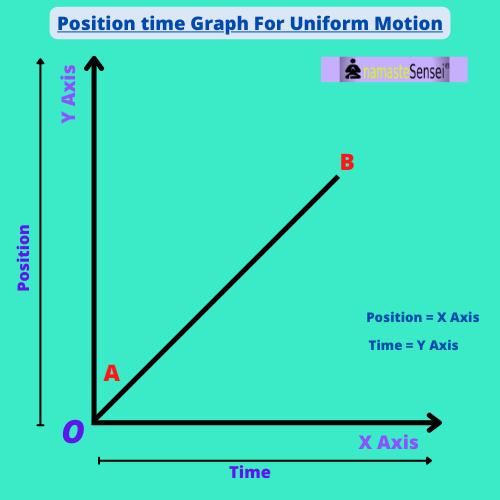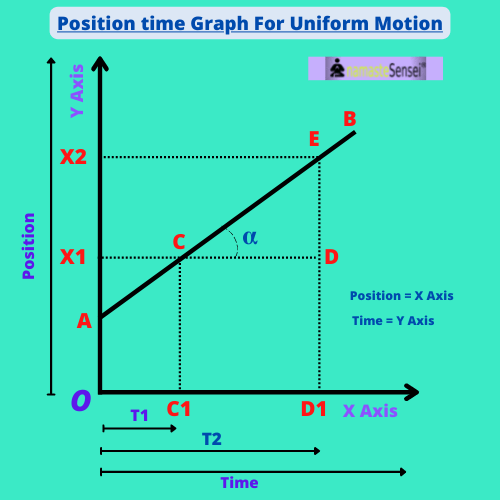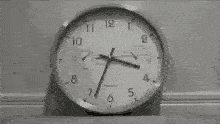-
Draw Position time graph for uniform Motion

Position time Graph For Uniform Motion
- When an object is in uniform motion, it travels an equal distance in equal intervals of time. i.e., the velocity remains constant throughout the motion.
- The Position-time graph for uniform motion is a straight line inclined to the time axis.
- The importance of the position-time graph of uniform motion lies because it inclined its slope to the time axis, which gives us the velocity of the object.
-
Use of position time graph for uniform motion
-
To Calculate Distance

- A position-time graph shows how far an object has traveled from its starting position since it started moving. The steeper the slope is, the greater the slope of the line and the faster the object’s motion is changing.
-
How to draw position time graph for uniform motion?
To draw Position-Time Graph (x-t graph) for uniform motion
- We always take the Independent variable on the x-axis. Here, time is the independent variable)
- We plot the dependent variable on the y-axis. Here, the position is the dependent variable)
- The dependent variable depends on the independent variable through some function.
Let us find out displacement for a body moving in uniform motion at a uniform velocity with zero acceleration.

To find displacement (ref above diagram)
|
Time taken – X-Axis
Position – Y-Axis
Steps to draw a position-time graph for uniform motion.
If we have knowledge of the angle (𝛂) then by calculating it’s Tan i.e. (Tan 𝛂) we can identify the uniform velocity of that uniform motion.
|
Recommended Read: What is uniform motion? Definition, Graph & Examples
-
Some Examples Related to Uniform Motion
- ROTATION OF EARTH AROUND ITS AXIS

The first one on my list is the earth’s rotation around its axis. If you are wondering how? then, let me tell you how.
- The rotation of the earth is Uniform Motion as it keeps happening over a period of time at a constant speed in a continuous process.
- The Earth’s axis runs from the North Pole to the South Pole. It takes the Earth 24 hours (Actual: 23 hours, 56 minutes), or one day, to make one complete rotation around this invisible line. As the Earth rotates, each area of its surface gets a turn to face and be warmed by the sun.
- Revolution/ orbital motion of Earth around the sun

- Earth revolves around the sun for 365 days, 6 hours, and 9 minutes with reference to the stars, at speed ranging from 29.29 to 30.29 km/s. The 6 hours, and 9 minutes add up to about an extra day every fourth year, which is designated a leap year, with the extra day added as February 29th.
- The Earth travels in an elliptical orbit around the sun. It travels at roughly 67,000 miles per hour (or 18.5 miles a second), on this path.
- This speed of the earth’s orbital motion or to make one revolution always remains constant. As a result, the Earth travels equal distances in fixed intervals of time. It does not happen that the Earth revolves around the sun in 100 days one time and then in 365 days the next time around. Here the earth covers equal distance in equal intervals of time.
- Movements of hands of a clock

- The distance traveled by the hands of a clock is fixed in fixed intervals of time. This means, that when an hour hand moves one unit distance, we say one hour has passed. When a second’s hand moves one unit we say 5 seconds have passed.
- Since this movement is uniform we are able to find the time. What if it moved one unit in 5 seconds and the other in 1 second, then we would never be able to guess time.
- A car moving on the highway with a fixed speed

- When you start a car, at first, the motion of a car is perfectly a non-uniform one. While driving on a highway, the road is clear of any traffic then we move ahead to speed it up and we can drive smoothly. After some time, when you have achieved your desired speed, what you wanna do is go smoothly. And especially if we put the car on cruise mode, the car will automatically cruise at the specified speed. There is no variation in speed. Hence, this is an example of uniform motion.
- But, this is not the case while driving in city traffic. We are constantly stopped by traffic lights and heavy traffic at peak hours. It is almost impossible to maintain a uniform speed. Driving in city traffic is an example of non-uniform motion.
Recommended Read: 11 Uniform Motion Examples In Real Life
Congratulations, you have read the complete article about the position-time graph for uniform motion. If you have any doubts or queries, feel free to comment below. We will respond as soon as possible.
Or Email Us At [email protected]
More Articles:
| Velocity Time graph for uniform Motion | Distance time graph for uniform motion |
| What is uniform motion? | 11 Uniform motion examples in real life |
Any topic you want us to cover? Let us know.
